✅ [M] HARDWARE AND FITTINGS
1/159
There's no tags or description
Looks like no tags are added yet.
Name | Mastery | Learn | Test | Matching | Spaced |
|---|
No study sessions yet.
160 Terms
Hardware
The metal tools, fastenings, and fittings used in construction
Rough Hardware
Bolts, screws, nails, and other metal fittings that are concealed in a finished construction
Finish Hardware
Exposed hardware serving a decorative as well as a utilitarian purpose, as the locks, hinges, and other accessories for doors, windows, and cabinetwork
Hinge
A jointed device, usually consisting of two leaves joined together by a pin, on which a door, gate, or shutter swings, turns, or moves
Leaf
A hinged, sliding, or otherwise movable part of a door, hinge, or tabletop

Gain
A notch cut into a surface to receive a leaf of hinge

Knuckle
The cylindrical, projecting joint of a hinge through which the pin passes

Mortise Hinge
A butt hinge mortise into the a abutting surfaces of the door and door jamb
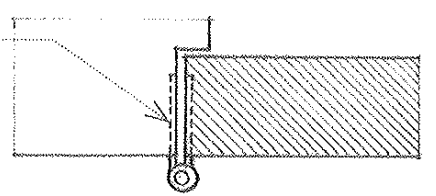
Half-Mortise Hinge
A hinge having one leaf mortise into the edge of a door in the other surface mounted to the door frame
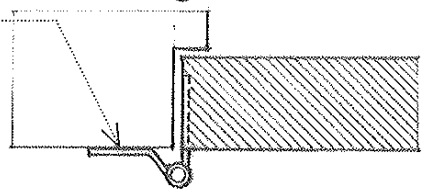
Half-Surface Hinge
A hinge having one leaf mortise into a door frame and the other surface mounted to the face of the door
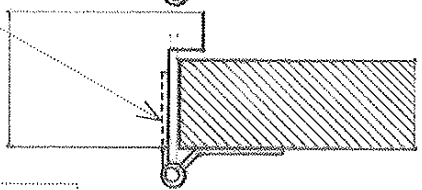
Flap Hinge
A hinge having to leave surface mounted two adjacent faces of a door and door frame
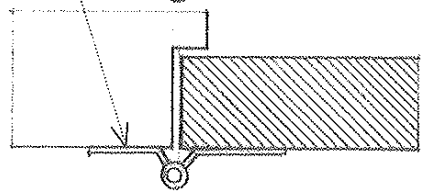
Butt Hinge
A hinge compose of two plates secured to the abutting surfaces of a door and doorjamb

Template Hinge
Mortise hinge manufactured to fit the recess and match the arrangement of the whole of the hollow metal doors and frames
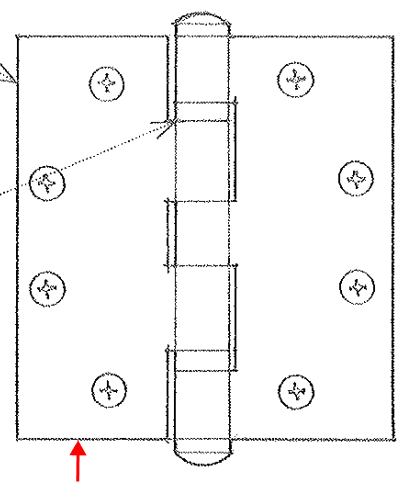
Ball-bearing Hinge
The hinge equipped with ball bearing between the knuckles to reduce friction and ensure ease of operation
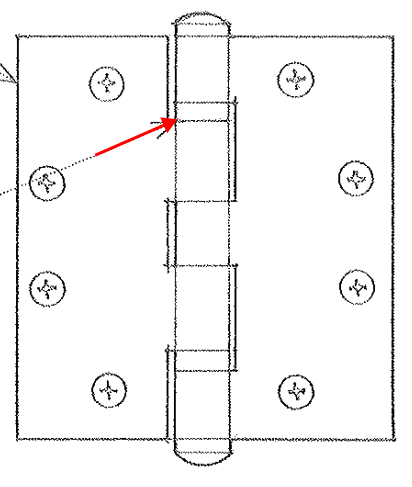
Fast-pin Hinge
The hinge having a non-removable pin
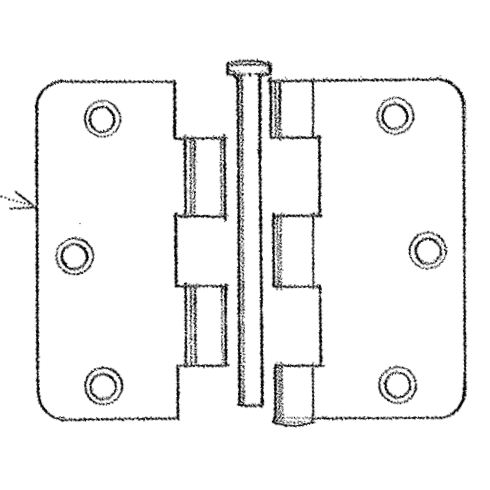
Loose-pin Hinge
Hinge having a removable pin so that the door can be enough by separating the two leaves
Loose-joint Hinge
A hinge having a knuckle formed from half of each leaf, with the upper half removable from the pin

Pintle
A pin or bolt on which something turns, such as the gudgeon of a hinge
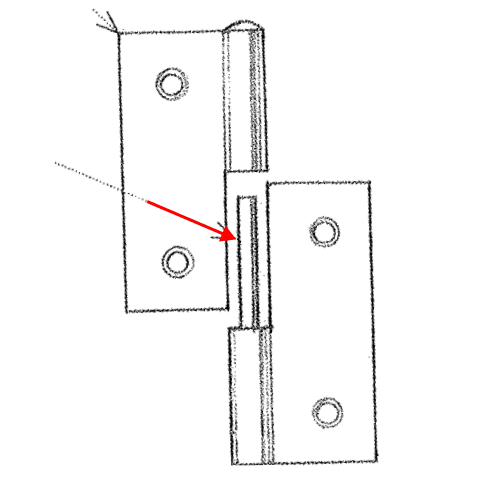
Gudgeon
A socket for pintle of hinge
Spring Hinge
A hinge containing a coiled spring in its barrel for closing the door automatically
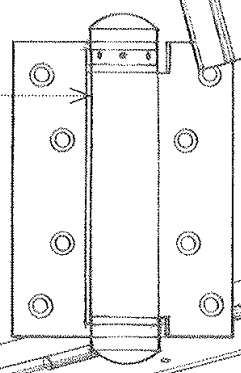
Double-acting Hinge
A hinge permitting a door to swing in either direction, usually fitted with springs to bring the door to a closed position after opening
Piano Hinge
A long, narrow hinge that runs the full length of the two surfaces to which its leaves are joined
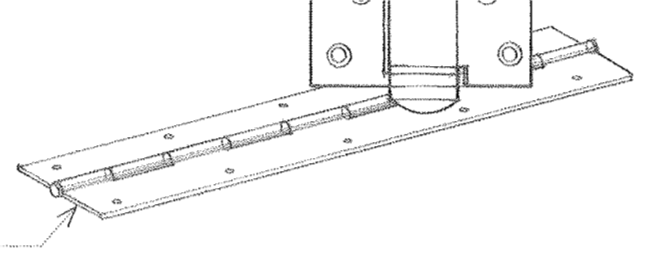
Strap Hinge
A hinge having two long leaves for securing to the adjacent faces of a door and doorjamb
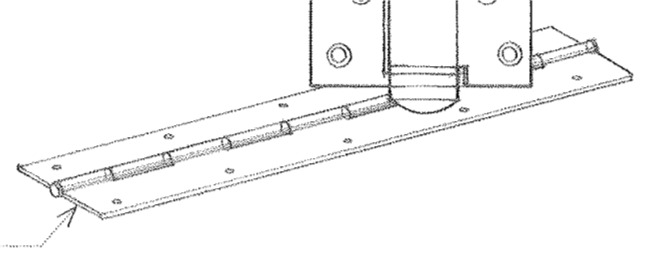
Cross-garnet
A T-shaped strap hinge with the crosspiece as the stationary member and the long stem being the movable leaf.
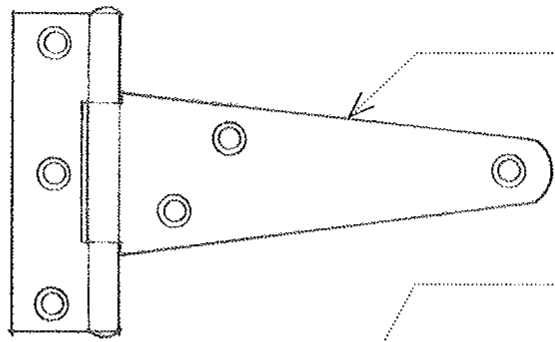
Dovetail Hinge
A strap hinge having leaves that are narrower at their junction than at their other extremities

Parliament Hinge
An H-shaped hinge having a protruding knuckle so that a door can stand away from the wall when fully opened
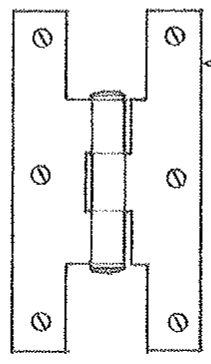
Paumelle
A hinge having a single, pivoting joint
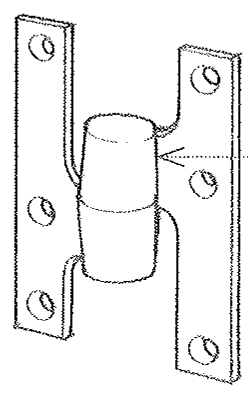
Olive Knuckle Hinge
A paumelle having an oval-shaped knuckle
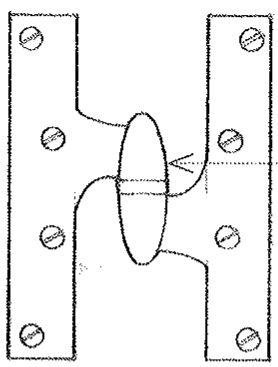
Gravity Hinge
A hinge that closes automatically by means of gravity
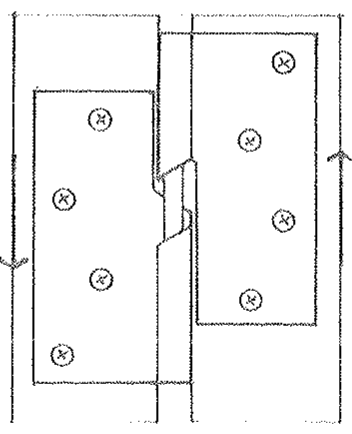
Rising Hinge
A gravity hinge causing a door to rise slightly when opened
Invisible Hinge
A hinge consisting of a number of flat plates rotating about a central pin, with shoulders mortised into the door edge and doorframe so as to be concealed when closed

Lock
A device for securing a door, drawer, or lid in position when closed, consisting of a bolt or combination of bolts propelled and withdrawn by a key- or combination-operated mechanism
Lockset
An assembly of parts making up a complete locking system including knobs, plates and a locking mechanism

Latch
A device for holding a door closed, consisting essentially of a bar that falls or slides into a groove or hole

Dead Bolt
A lock having a square head that is moved into position by the turning of a knob or key rather than by spring action
Latch Bolt
A spring bolt, one edge of which is beveled; when the door or window to which it is attached is closed, the bolt is forced inward; when in the fully closed position, the bolt springs back into a fixed notch or cavity
Mortise Lock
A lock housed within a mortise cut into a door edge so that the lock mechanism is covered on both sides
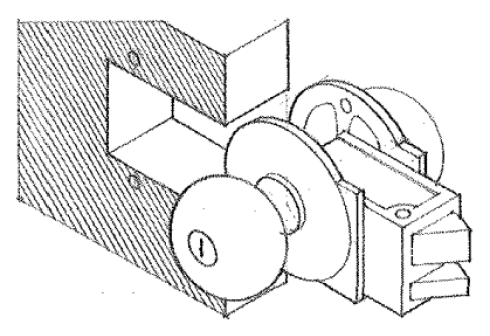
Unit Lock
Also known as Preassembled Lock and Latch; A lock housed within a rectangular notch cut into the edge of a door
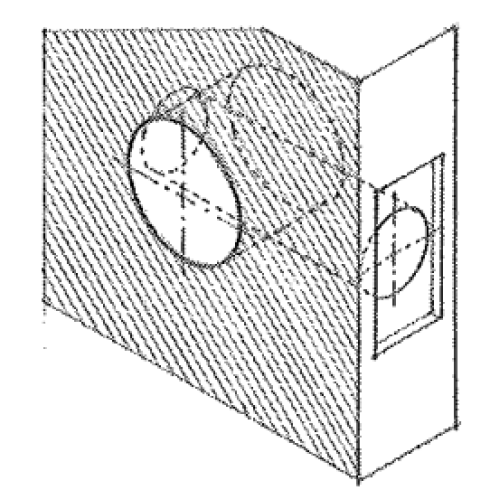
Cylinder Lock
Also known as Bored Lock and Latch; A lock housed withing two holes bored at right angles to each other, one through the face of the door and the other in the door edge
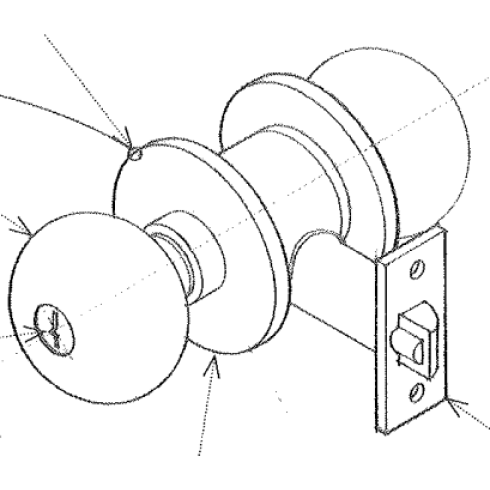
Interconnected Lock
Have a cylinder lock and a dead bolt; The two locks are interconnected so that a single action of turning a knob or level handle on the inside releases both bolts

Deadlock or Deadbolt
A lock having a square head that is moved into position by the turning of a knob or key rather than by spring action
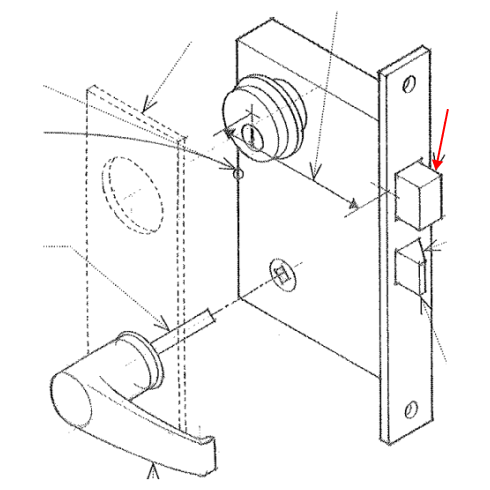
Bolt
A metal bar or rod in the mechanism of a lock that is propelled or withdrawn, as by turning a knob or key
Escutcheon
A protective or ornamental plate, as around a keyhole, doorknob, drawer pull, or light switch

Lever Handle
A horizontal handle for operating the bolt of a lock
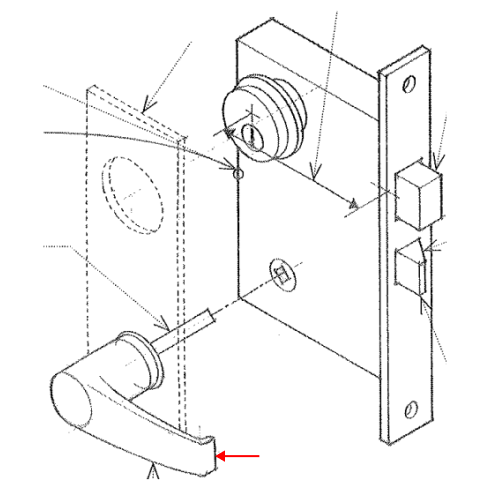
Spindle
The bar or shaft that carries the knobs and actuates the latch or bolt of a lock
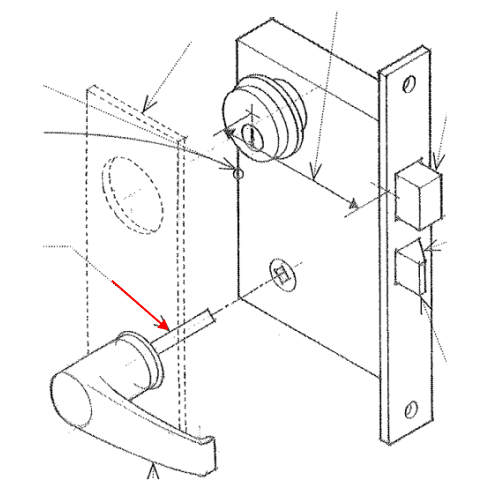
Bevel
The oblique end of a Latch bolt that hits a strike plate
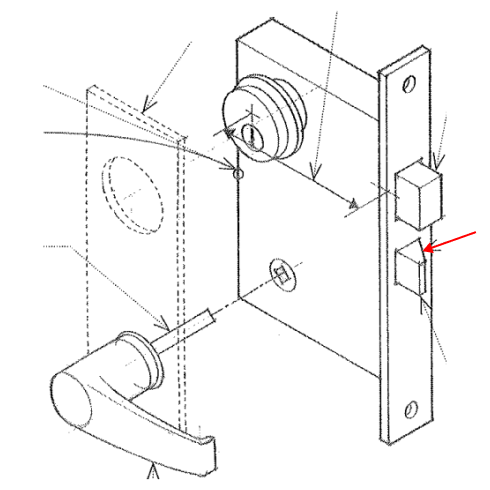
Latchbolt
A lock bolt having a beveled head that is moved into position by a spring except when retracted by a doorknob, or when pushed against the lip of the strike plate as the door is closed
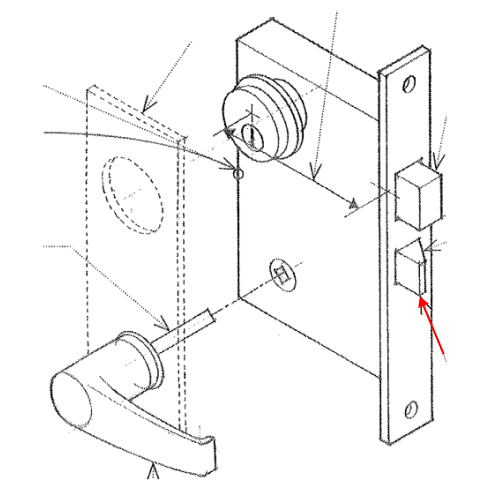
Extension Bolt
A flush bolt fitted into a mortise in a door, sliding into a socket in the head or the sill
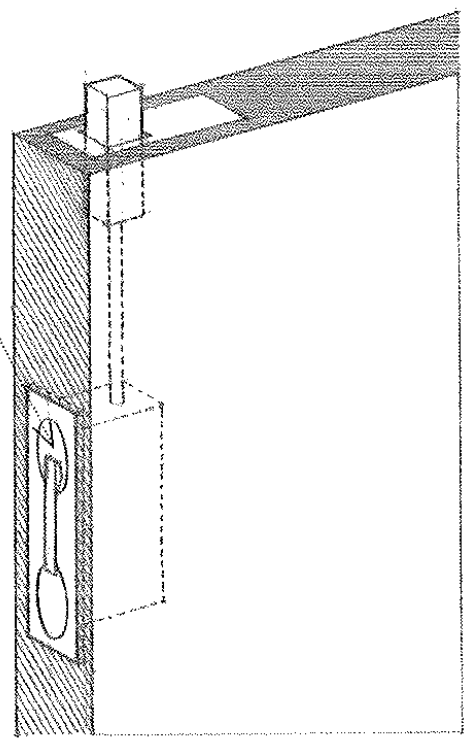
Flush Bolt
A bolt set flush with the face or edge of a door
Coordinator
A device for ensuring that the inactive leaf of a pair of doors is permitted to close before the active leaf
Backset
The horizontal distance from the face of a lock through which the bolt passes to the centerline of the knob stem, keyhole or lock cylinder

Doorknob
The knob-shaped handle by which a door is opened or closed
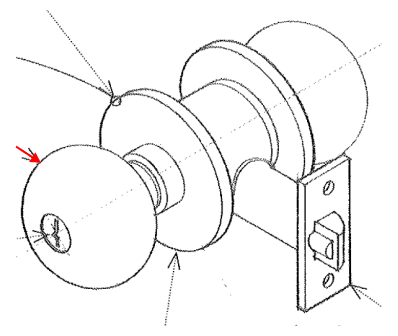
Keyhole
A hole in a lock case or escutcheon for inserting a key
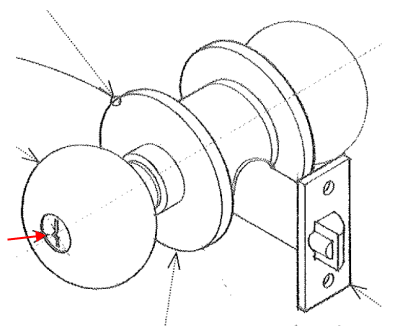
Rose
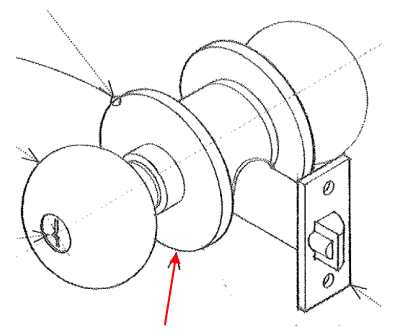
Faceplate
An ornamental plate surrounding the shaft of a doorknob
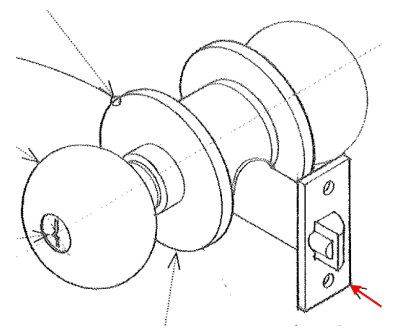
Strike
A metal plate on a door jamb having a hole for receiving the end of a lock bolt when the door is closed. Also called strike plate

Lip
The projecting edge or rim of a strike
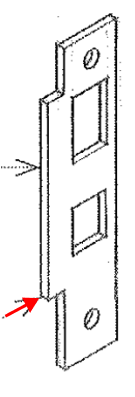
Box Strike
A metal box recessed into a door jamb to receive the end of a lock bolt when the door is closed
Key
A small metal instrument specially cut to fit into a lock and move its bolt
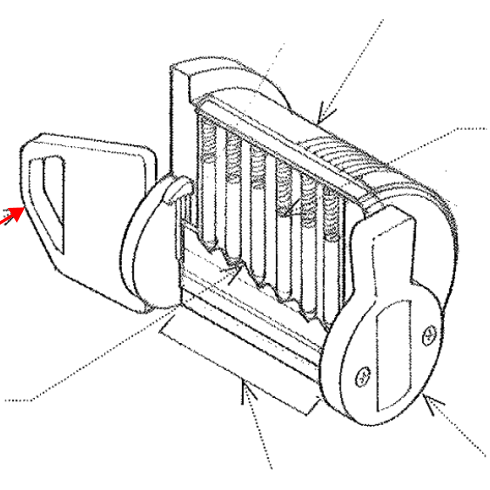
Bit
One of the projecting blades cut to engage with and actuate either or both the bolt and the tumblers of a lock

Keyway
A slot in a lock for receiving and guiding a key
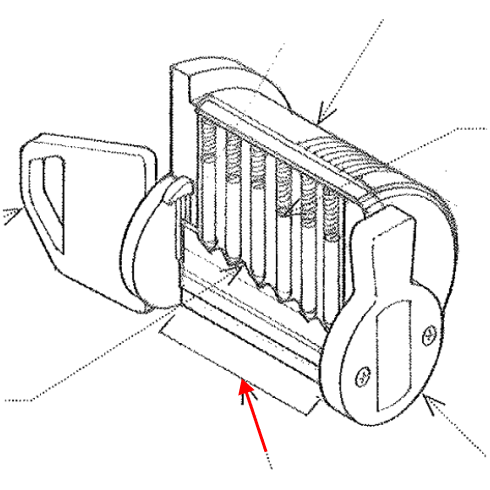
Cylinder
A cylinder device for retaining the bolt of a lock until the tumblers have been pushed out of its way
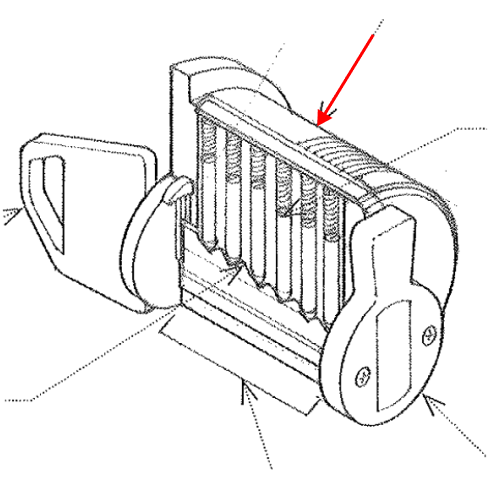
Tumbler
An obstructing part in a lock that prevents a bolt from being propelled or withdrawn until it is moved by the action of a key
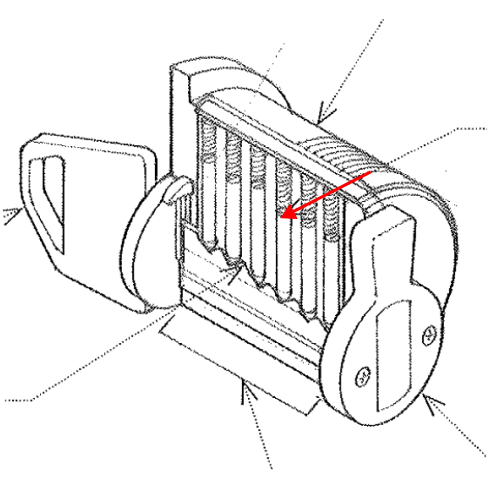
Lever Tumbler
A flat metal tumbler having a pivoting motion actuated by the turning of a key
Ward
A projecting ridge of metal in a lock or keyhole that prevents the insertion of any key that does not have a corresponding notch
Cam
A disk or cylinder having an irregular form that rotates or slides to impart motion to a roller moving against its edge or to a pin free to move in a groove on its face

Pivots
Provides an alternative way to hang doors where the visual appearance of hinges is objectionable or where a frameless door design may make it impossible to use hinges; May be center hung or offset and mounted in the floor and head of the door
Panic Bar
A horizontal bar that spans the interior of an emergency exit door at waist height and that opens the latch when pressure is applied
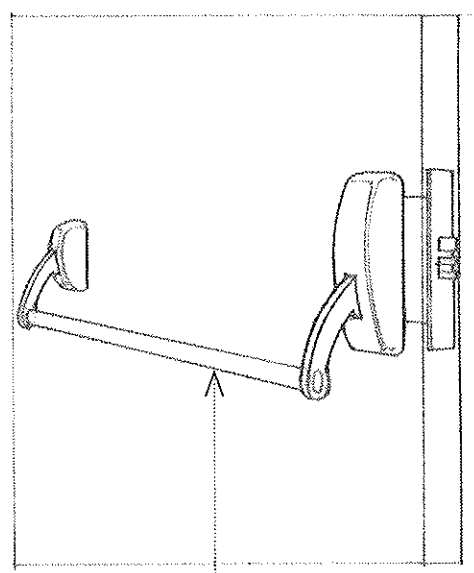
Push Plate
A protective plate of metal or plastic mounted vertically on the lock stile of the door

Door Pull
Handle for opening a door by pulling action
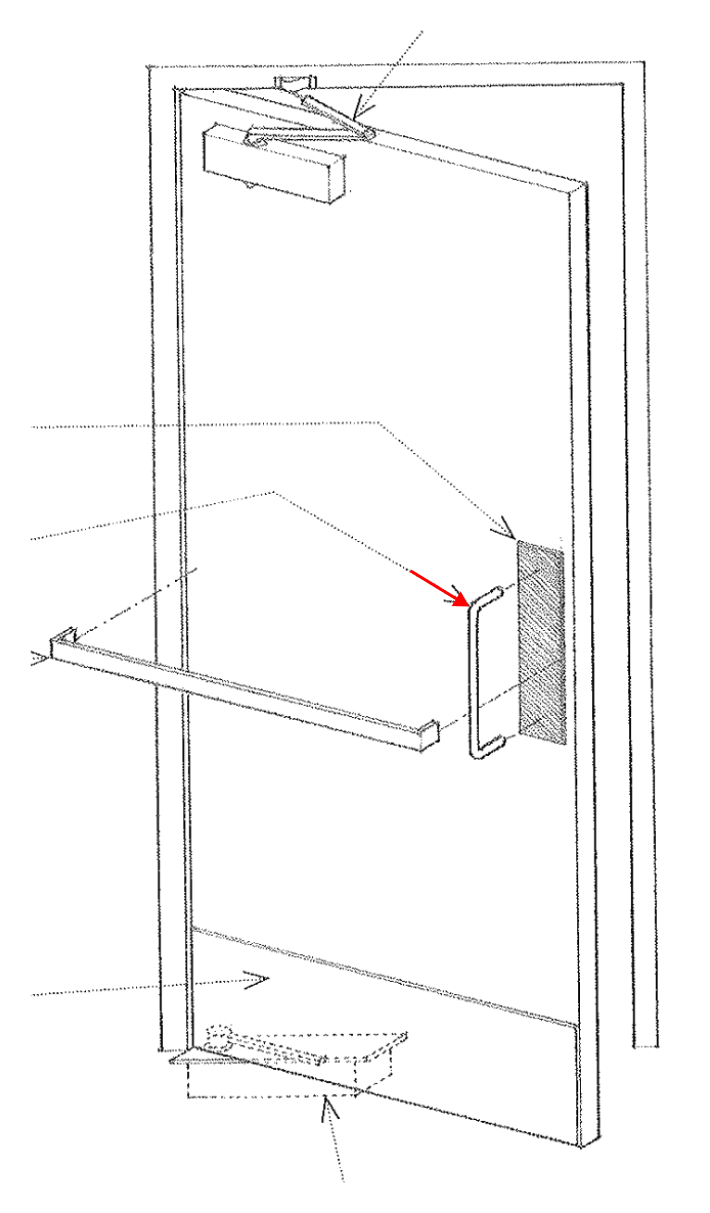
Pull Bar
A bar fixed across a glazed door, used for opening or closing the door and providing protection for door glass

Kick Plate
A protective metal plate fastened to the bottom of a door to resist blows and scratches
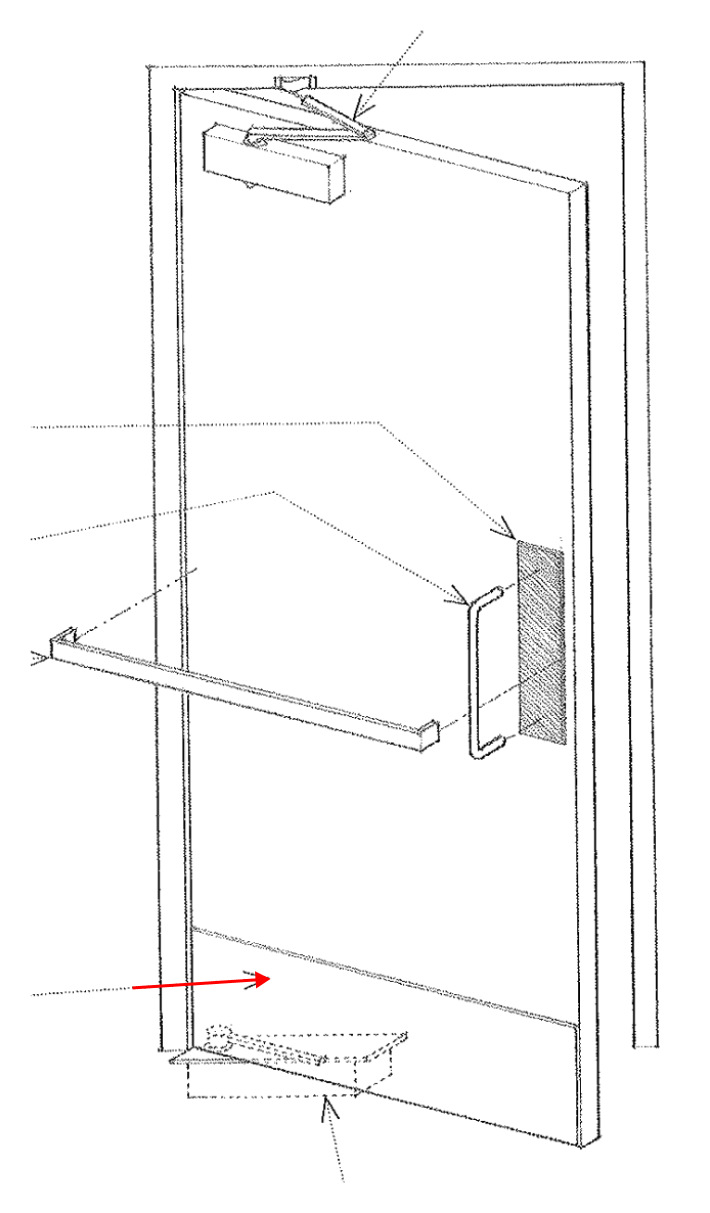
Door Closer
A door closer installed in a recess in the floor

Floor Closer
A door closer installed in a recess in the floor

Automatic Door Bottom
A horizontal bar at the bottom of a door that drops automatically when the door is closed in order to seal the threshold and reduce noise transmission
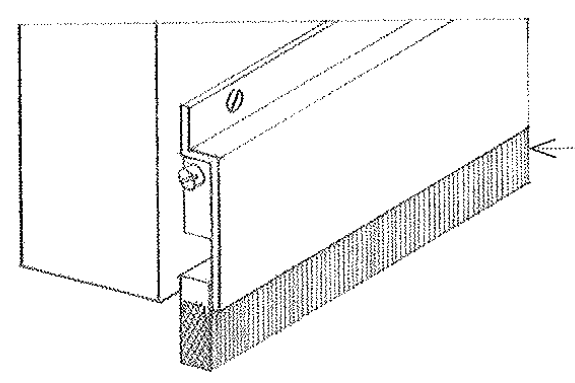
Judas
A peephole, as in an entrance door or the door of a prison cell
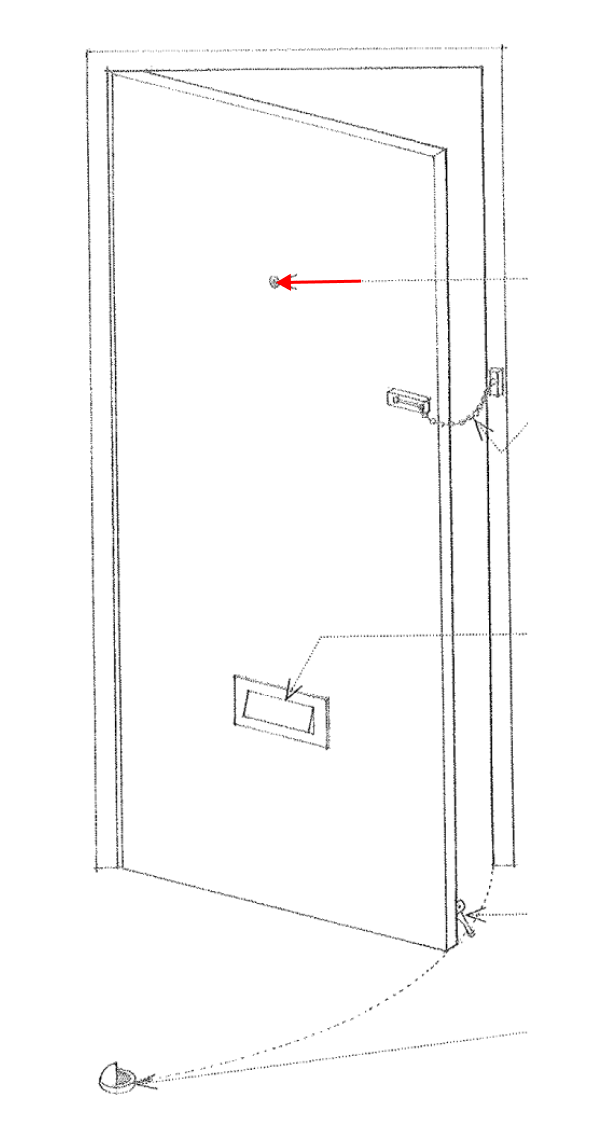
Door Chain
A short chain with a removable slide fitting that can be attached between the inside of a door and the doorjamb to prevent the door from being opened more than few inches without the chain being removed
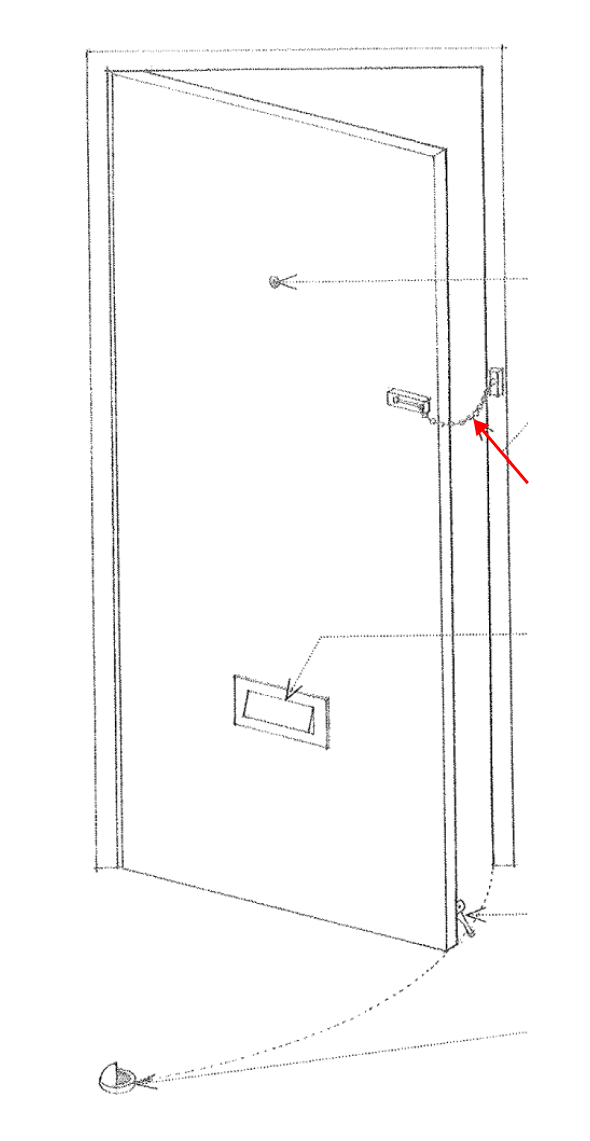
Mail Slot
A small opening in an exterior door or wall, often with a hinged closer, through which mail is delivered
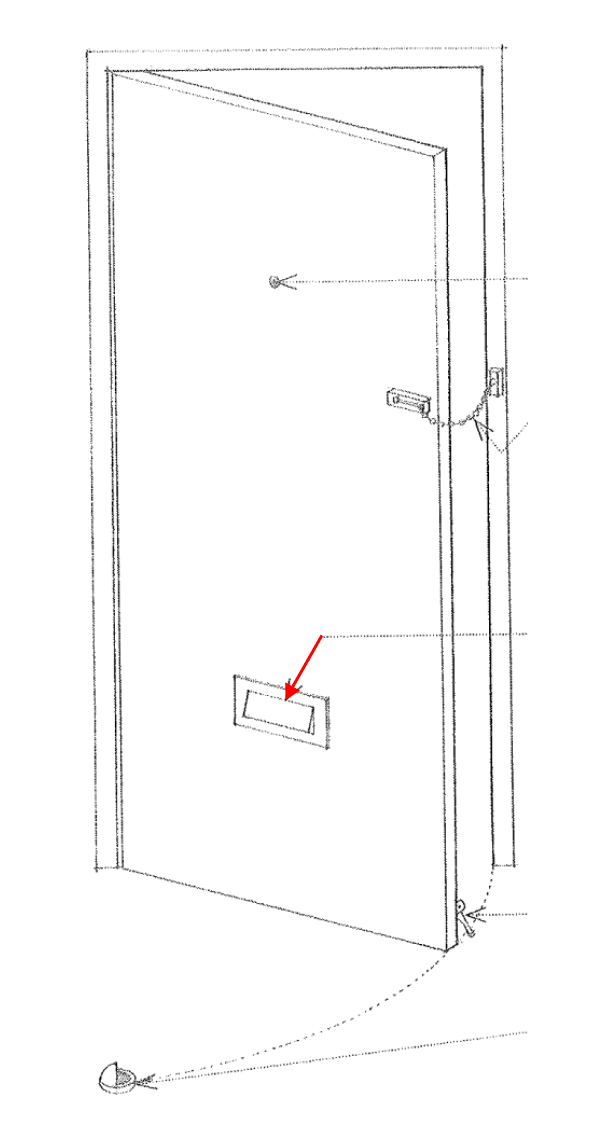
Doorstop
A device for holding a door open, as a wedge or small weight

Bumper
A projecting rim, guard, pad, or disk for absorbing shock or preventing damage from bumping

Left-hand
Having the hinges on the left of the inward opening door when seen from the exterior of the building or room to which the doorway leads

Left-hand reverse
Having the English on the left of an outward opening door when seen from the exterior of the building or room to which the doorway leads
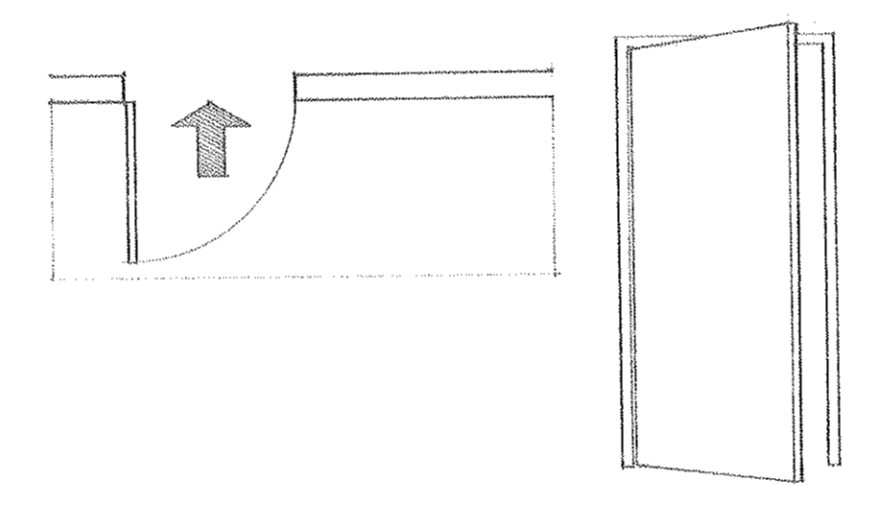
Right-Hand
Having the hinge on the right open inward opening door when seen the exterior of the building or room to which the door way leads
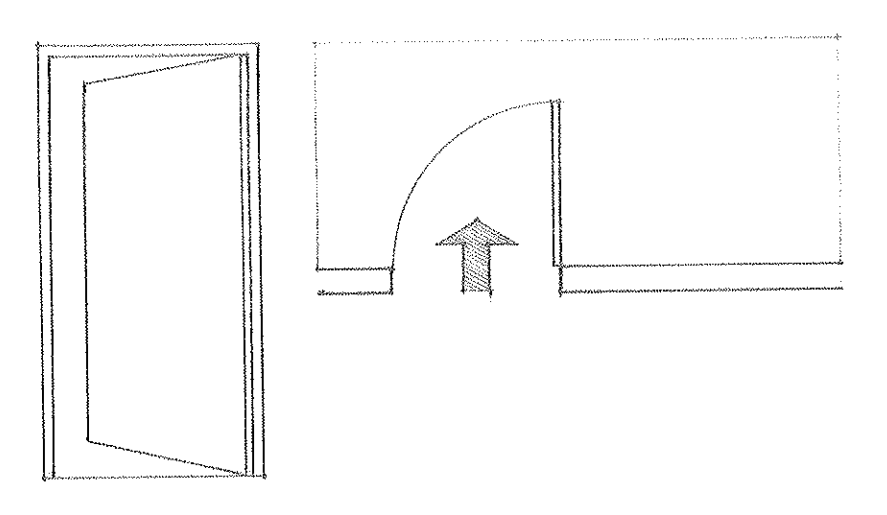
Right-hand Reverse
Having the hinge on the right open outward opening door when seen the exterior of the building or room to which the door way leads
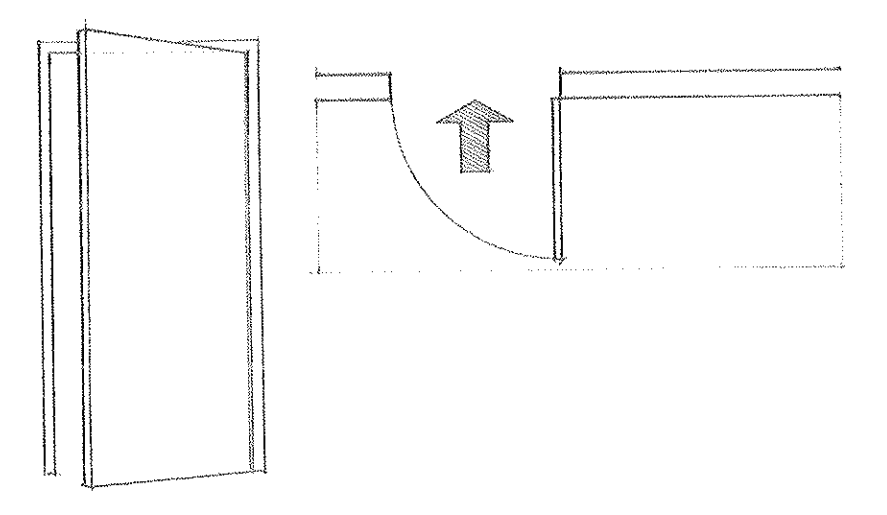
Astragal
Vertical members used between double doors to seal the opening, act as a door stop, or provide extra security when the doors are closed
Nail
A straight, slender piece of metal having one end pointed and the other enlarged and flattened for hammering into wood or other building materials as a fastener
Penny (D)
What is the designated length of a nail?
Twopenny to Sixtypenny
What are the lengths of a nail?
Shank
The straight, narrow part of a nail or bolt, between the head and the point

Cut Nail
A nail having a tapering rectangular shank with a blunt point, made by cutting and shaping piece of round or elliptical steel

Common Nail
A nail having a slender shank, a flat head and a diamond point

Wire Nail
A nail made by cutting and shaping a piece of round or elliptical wave

Box Nail
A nail having a flat head and a shank more slender than a common nail of the same length

Casing Nail
A nail having a small conical head and shank more slender than a common nail of the same length, used in finish work in which the head may remain visible

Finishing Nail
A nail having a slender shank and small, barrel shaped head that is driven slightly below the surface and covered with putty or the like

Brad
A small finishing nail

Double-headed Nail
A nail used in building temporary structures, such as scaffolding and formwork, having a flange on its shank to prevent it from being driven in all the way and to leave the head

Concrete Nail
Also known as Masonry Nail; A hardened-steel nail having a fluted or threaded shank and a diamond point for hammering into concrete concrete or masonry

Flooring Nail
A nail for fastening floor boards, having a small conical head, a mechanical deformed shank and a blunt diamond point

Ring-shank Nail
A nail having a series of concentric grooves on its shank for increased holding power
